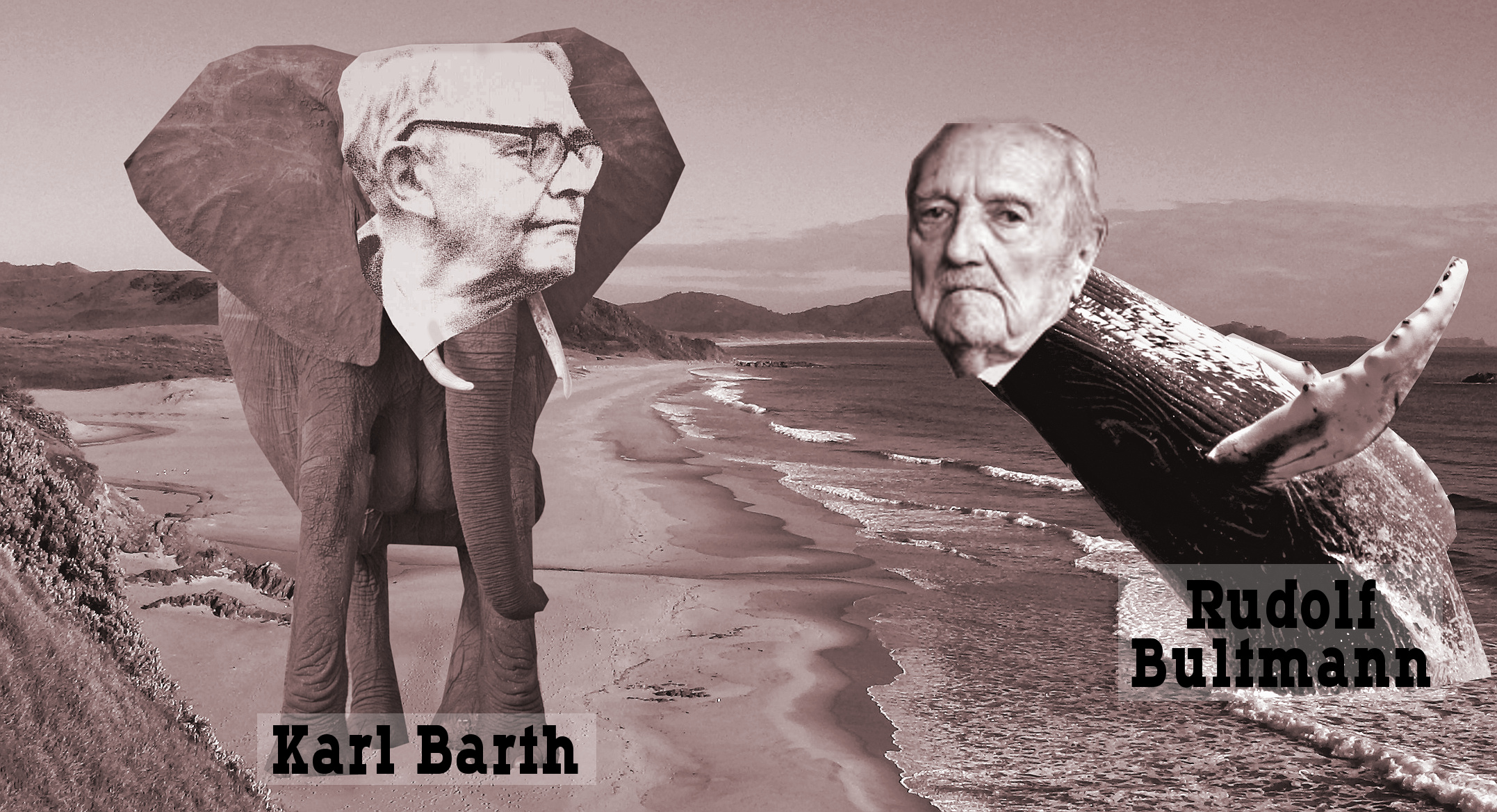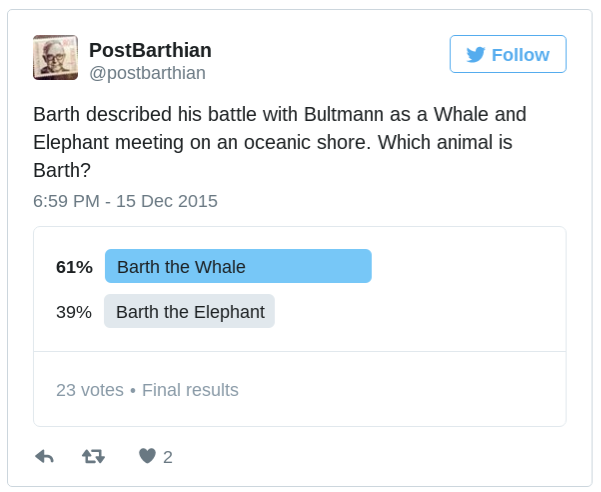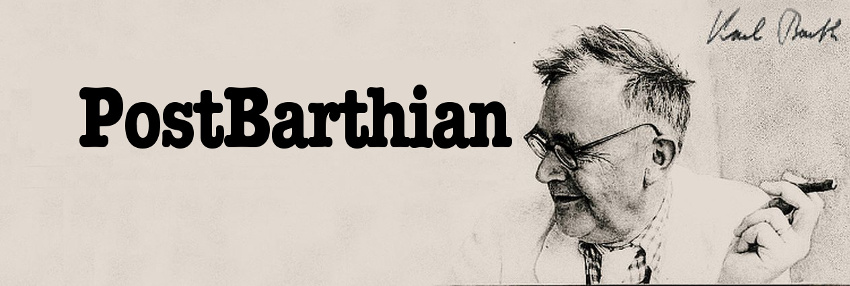 Karl Barth and Rudolf Bultmann did not get along. A long long time ago, in a galaxy far far away, they were once friends, but as each developed their own theological program, their alliance deteriorated into an operatic tragedy. In the Christmas season of 1952, Barth and Bultmann exchanged a famous set of letters where Barth declared that their differences were as irreconcilable as a "whale . . . and an elephant meeting with boundless astonishment on some oceanic shore." This 1952 Christmas Correspondence between Barth and Bultmann has been studied at length by many theologians, especially those who wish to defend Barth's criticisms of Bultmann or to reconcile their theologies. The following is an exploration of this operatic, tragic tale of The Whale and the Elephant.
Karl Barth and Rudolf Bultmann did not get along. A long long time ago, in a galaxy far far away, they were once friends, but as each developed their own theological program, their alliance deteriorated into an operatic tragedy. In the Christmas season of 1952, Barth and Bultmann exchanged a famous set of letters where Barth declared that their differences were as irreconcilable as a "whale . . . and an elephant meeting with boundless astonishment on some oceanic shore." This 1952 Christmas Correspondence between Barth and Bultmann has been studied at length by many theologians, especially those who wish to defend Barth's criticisms of Bultmann or to reconcile their theologies. The following is an exploration of this operatic, tragic tale of The Whale and the Elephant.
The 1952 Christmas Correspondence: An Introduction
Kerygma and Myth II was a book in a series that contained essays by Rudolf Bultmann with critical responses from famous theologians (see here for more info), including Karl Barth's famous essay Rudolf Bultmann: An Attempt to Understand Him (mirror). This essay initiated a series of letters between Bultmann and Barth that I've dubbed The 1952 Christmas Correspondence. Bultmann responded to Barth's essay in an almost twenty page personal letter that I'll call his November letter, in which Karl Barth responded with his Christmas Eve letter that contains the famous Tale of the Whale and the Elephant: These two complete letters are contained in Karl Barth - Rudolf Bultmann: Letters 1922 - 1962. I recommend reading the entire correspondence beginning with Barth's essay and ending with his Christmas Eve letter to obtain a fuller picture of the selections quoted here.
The Tale of the Whale and the Elephant
Here is the quotation from Karl Barth's 1952 Christmas Eve letter containing The Tale of the Whale and the Elephant. (I've placed the key sentences in bold.)
Basel, 24 December 1952
Dear Mr. Bultmann,
. . . I am constantly listening to you in my ongoing work as you try to stop me doing the things that I then obstinately do all the same. I, too, am a Don Juan who certainly hears the powerful bass of Komtur, but does not repent as demanded.
Is it clear to you how things are with us—you and me? It seems to me that we are like a whale (do you know Melville's remarkable book Moby Dick? You ought to have a high regard for it because of its animal mythology!) and an elephant meeting with boundless astonishment on some oceanic shore. It is all for nothing that the one sends his spout of water high in the air. It is is all for nothing that the other moves its trunk now in friendship and now in threat. They do not have a common key to what each would obviously like to say to the other in its own speech and in terms of its own element. A riddle of creation whose solution in the eschaton I like to depict as Bonhoeffer does by pointing toward the "I restore all things" of the Christmas hymn. . . .
Yours,
Karl Barth
Barth, Karl, and Rudolf Bultmann. Karl Barth - Rudolf Bultmann Letters, 1922-1966. Ed. Bernd Jaspert and G. W. Bromiley. Trans. G. W. Bromiley. Grand Rapids, MI: Eerdmans, 1981. 105. Print.
An Animal Mythology: Willie the Operatic Whale
Barth's reference to "animal mythology" and Moby Dick reminded me of the old Disney cartoon The Whale Who Wanted To Sing At The Met (1946) that is significantly similar to The Tale of the Whale and the Elephant. Willie the Operatic Whale is a mysterious whale that wanders through the sea singing to all who will hear him. He is able to simultaneously sing with three different operatic voices simultaneously due to a mutation and performs many opera selections throughout the cartoon. The cartoon contains a dream sequence showing Willie's renown fame and success after his discovery, with an iconic scene with Willie in a costume singing as he towers over a full house at the Metropolitan Opera in New York City.
In hopes of being discovered, Willie approaches a whaling ship and sings a selection from Figaro. The sailors attempt to harpoon Willie, but are quickly wooed by his singing, but sadly the captain of the vessel is not deterred (like Ahab) and harpoons Willie. In the end, Willie goes to the special part of heaven for creatures of the deep where his operatic skills are finally appreciated. The cartoon oddly concludes that it was for the best that Willie was harpooned, because there was no way he would have ever sung at the Met, and only now, in the dreamy glow of heaven far away, Willie may at last be "understood".
Listen to Willie sing Figaro (or watch the entire 15min cartoon):
Whale or Elephant: A Short Excursus on Who's Who
 Is Barth the Elephant or the Whale? This is a hotly debated question! I've depicted Barth as the elephant in the header image but my recent twitter poll results indicated that opposite: Barth is the whale and Bultmann is the elephant. The whale is an impressive megafauna, this a mammal that once walked on land but later returned to the sea. The elephant is the greatest land animal and is one of few animals to exhibit mirror recognition. So there is no advantage to being the whale or elephant.
Is Barth the Elephant or the Whale? This is a hotly debated question! I've depicted Barth as the elephant in the header image but my recent twitter poll results indicated that opposite: Barth is the whale and Bultmann is the elephant. The whale is an impressive megafauna, this a mammal that once walked on land but later returned to the sea. The elephant is the greatest land animal and is one of few animals to exhibit mirror recognition. So there is no advantage to being the whale or elephant.
The English translation of Barth's Christmas Eve letter favors identifying Barth with the whale, especially since his Church Dogmatics have been called a 'Moby Dick' for its great length. So who is who? They are both the whale and are both the elephant. This will be made clear by the way both Barth and Bultmann refer to themselves as Don Juan.
Karl "Don Juan" Barth
In the Christmas Eve letter, Barth refers to himself as "Don Juan" which is the Spanish version of the famous opera Don Giovanni by Mozart. Barth loved Mozart and frequently referenced him in his writings, and also wrote a book titled Wolfgag Amadeus Mozart. In the opera, Don Juan receives a dinner invitation to the netherworld by the powerful bass of the undead "Komthur" (a.k.a "Commentadore" who coincidentally resembles a white whale), but Don Juan strongly resists. The Komthur compels Don Juan to attend, and finally tells Don Juan his time is up, and then Don Juan is dragged off into the realm of fiery devils. This scene is figurative of Barth's relationship to Bultmann in this correspondence.
(Don Juan is a legendary womanizer that frequently appears in popular culture and movies as a sex symbol similar to Casanova. Barth does not identify himself as Don Juan because he believes he is a sex symbol(!). He does so because this finale scene Don Juan's encounter with from the famous finale of the opera Don Giovanni.)
Watch this video from the finale of Don Giovanni and imagine Karl Barth as Don Juan under the inquisition of Rudolf Bultmann as the Komthur. Imagine Barth resisting Bultmann like Don Juan resists the commands of the undead Komthur.
https://www.youtube.com/watch?v=dK1_vm0FMAU
Rudolf "Don Juan" Bultmann
Bultmann was the first to identify as "Don Juan" in his 1952 November letter to Barth as a way of responding to the inquisition of Barth's essay: Rudolf Bultmann: An Attempt to Understand Him. Bultmann believed he had already answered Barth's essay in Kerygma and Myth II with his own contribution to that same book: The Case for Demythologizing: A Reply (mirror). It may have been this point that prompted Barth to respond in the strong protest that Bultmann feared,"Ah, your time is up!", in Barth's response of The Tale of the Whale and the Elephant.
At first I was tempted to cap your quotation from Figaro with one from the end of Don Giovanni: Komthur [K.B.]: "Pentiti!" (Repent / Confess) Don Giovanni [R.B.]: "No!" But I resisted this so as not to lead you into the temptation of answering me as Komthur (Commendatore): "Ah! tempo più non v'è!" (tr. Ah, your time is up!) I thus decided to reply to you directly, though with some doubt whether I would succeed in making myself understood, since I believe that the answers to your questions are basically already given in my contribution to Kerygma and Myth II.
Ibid. 87
Mozart's Figaro: An Understanding Between the Whale and Elephant
Bultmann's letter references Figaro, and this back story reveals an unrealized hope that Barth and Bultmann may have worked out their differences and become friends once again. In the second finale of Figaro, it is revealed that the beloved mistress is the wife in disguise. "Oh Angel, pardon me" is the reply to this deception, and Barth quotes it to suggest that their disagreements could have been resolved, but sadly no such reconciliation occurred between them.
Watch the following scene from Figaro and imagine Barth saying "Angel, pardon me" after the mistress (imagine as Bultmann) reveals she has been his wife all along:
Conclusion
Whether Barth and Bultmann may be reconciled or not is a larger question than may be answered at this time. What may be said is that Barth did not believe his theology may be reconciled with Bultmann's. Bultmann believed he had answered Barth's criticisms and the Tale of the Whale and the Elephant may turn out to be an animal mythology. However, Barth emphatically disagreed with Bultmann, and remained adamant about it until the end. To reconcile Barth and Bultmann, one of these two famous theologians are required to change. Barth has been said to be inconsistent, but Barth did not believe that he was. The long back story reveals that they were well acquainted with each other's theologies, and although reconciliation might have been achieved by some changes by both sides, but the "Oh Angel, pardon me!" was never sung. This is The Tale of the Whale and the Elephant.
- Header Source is a composite of these images:
- "Karl Barth Letters 1961-1968" by CHRIS DRUMM - https://secure.flickr.com/photos/cdrummbks/3548684024/in/photolist-5aUv4W-bDEbwt-phdnir-pysaNv-4PVTQW-6pzW8j-nxDMa8-okihxY-dvjuvA-bqKg11-bqKfWm-bqKfTU-bqKfS1-bDEb7B. Licensed under CC BY 2.0 via Commons.
- "Rudolf Bultmann Portrait" by Jü - Own work. Licensed under Public Domain via Commons.
- "Humpback stellwagen edit" by Whit Welles Wwelles14 - Own work. Licensed under CC BY 3.0 via Commons.
- "African Bush Elephant" by Muhammad Mahdi Karim FacebookThe making of this document was supported by Wikimedia CH. (Submit your project!)For all the files concerned, please see the category Supported by Wikimedia CH. - Own work. Licensed under GFDL 1.2 via Commons.



April 17th, 2016 - 13:36
This was interesting!
May 2nd, 2016 - 21:07
Thanks!